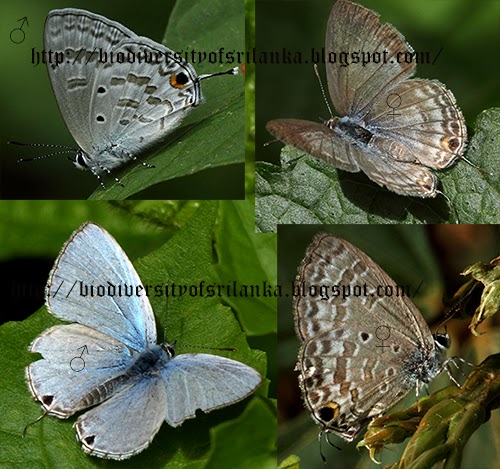Pages
- Home
- Flora of Sri Lanka
- Dragonflies & Damselflies of Sri Lanka
- Butterflies of Sri Lanka
- Freshwater Fishes of of Sri Lanka
- Amphibians of Sri Lanka
- Snakes of Sri Lanka
- Tetrapod Reptiles of Sri Lanka
- Mammals of Sri Lanka
- Resident Birds of Sri Lanka
- Migrant Birds of Sri Lanka
- Vagrant Birds of Sri Lanka
- Status Uncertain or Doubtful Birds of Sri Lanka
Tuesday, December 31, 2013
Sunday, December 29, 2013
Friday, December 27, 2013
Cornelian (Deudorix epijarbas epijarbus)
Tuesday, December 24, 2013
Monday, December 23, 2013
Curlew Sandpiper (Calidris ferruginea)
Very common winter migrant inhabiting saltarns, estuaries, lagoons, mud-flats and marshes of dry zone coastal areas and occasionally in wet zone. It occurs as large to small flocks, sometime associating with other waders and feeds busily on numerous small organisms, worms, molluscs etc. exposed in mud-flats when tide is running out. It breeds in Tundra in arctic eastern Asia.
සිංහලෙන් කියවන්න >>
Saturday, December 21, 2013
Thursday, December 19, 2013
Yellow-eared Bulbul(Pycnonotus penicillatus)
An endemic bird common in forests, well wooded home gardens and such habitats from mid to higher hills. Yellow-eared Bulbul usually lives as pairs or as small flocks and feeds on fruits and insects in bushes and low trees, moving from tree to tree, usually uttering its flight call. The breeding season last from March to April and probably again from August to September. It build a cup shape nest with green moss, rootlets, etc. placed in a fork of low tree or on a hanging branch.
සිංහලෙන් කියවන්න >>
Tuesday, December 17, 2013
Sunday, December 15, 2013
කට කලු කටුස්සා/Black-cheek Lizard/Dark-lipped Lizard(Calotes nigrilabris)
de Silva A., 2007 - The diversity of Horton plains national park (with specieal reference to its herpetofauna)
Friday, December 13, 2013
Wednesday, December 11, 2013
One-spot Grass Yellow (Eurema ormistoni)
Rare endemic butterfly found in wet zone forests up to elevation of about 3500ft. As per Woodhouse "it can be taken in numbers at the right time-April and July to September..." (Woodhouse L.G.O.,1950). d'Abrera also noted that it has only been sighted at certain times of the year from April sporadically to September (d' Abrera Bernard, 1998). Above specimen was photographed at Ingiriya forest reserve (Dombagaskandha) in mid February. Its larval host plants are Ventilago madraspatana (යකඩ වැල් ) and Ventilago gamblei.
Monday, December 9, 2013
නෙළු [Nelu] (Strobilanthes viscosa)
An indigenous shrub found in forests and secondary scrub lands of montane areas in the central highlands. Flowering from November to March and unlike other Strobilanthes species this species appeared to be found in flower every year. Two varieties occurs in Sri Lanka and variety digitalis found only in knuckles range while variety viscosa restricted to central highlands around Adam's peak and Nuwaraeliya district.
Saturday, December 7, 2013
මයිලගොයා[Mayilagoya]/Sri Lanka Wood Pigeon (Columba torringtoniae)
Sri Lankan Wood Pigeon is a rare hill country bird inhabiting forests and well wooded places. It also visits some low country rain forests especially during fruiting season. It lives as solitary birds, as pairs or as small flocks and feeds on fruits. The breeding season last from February to May and again from August to October. The nest is a platform of twigs on the canopy of forest tree, where it lays single white egg.
සිංහලෙන් කියවන්න >>
Thursday, December 5, 2013
වල් උඳු[Wal Undu] (Flemingia macrophylla)
Special thanks goes to Ishara Harshajith Wijewardhane - who discovered both plant and butterfly - for guiding us to above location.
Tuesday, December 3, 2013
Silver Forget-me-not (Catochrysops panormus)
Silver Forget-me-not is a very rare butterfly found in moist parts of the country though there are earlier records from Haldummulla and Wellawaya (Ormistom W., 1924). Males do mud puddling. No records available on its food plant or on early stages.
* Egg laying and larval feeding has been observed on වල් උඳු[Wal Undu] (Flemingia macrophylla) plants (Ishara Harshajith Wijewardhane, Personnal communication, November 24, 2013)
*Neustanthus phaseoloides [Syn: Pueraria phaseoloides is also identified as a larval host plant of it
Sunday, December 1, 2013
Subscribe to:
Posts (Atom)















